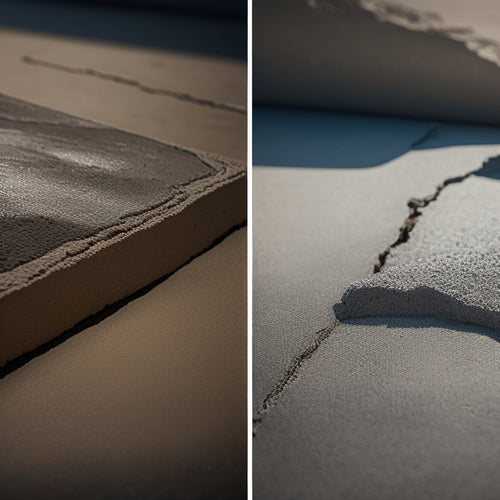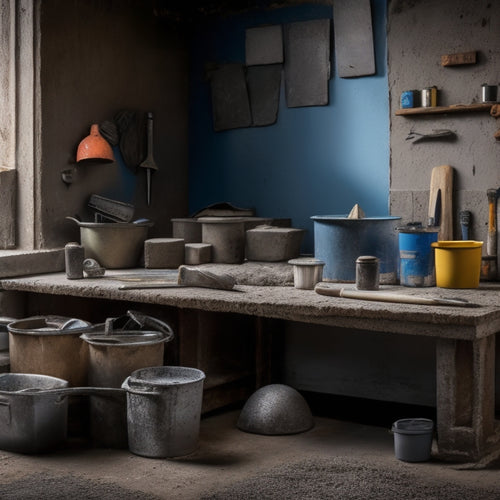
Durable Handles for Concrete Finishing Tools Tested
Share
When selecting durable handles for concrete finishing tools, you'll want to prioritize materials like fiberglass or high-grade aluminum. These options deliver strength while minimizing weight, which helps reduce fatigue during extended use. Rigorous testing methods evaluate durability, including impact and abrasion tests, ensuring handles can withstand tough conditions. Ergonomic designs enhance user comfort, allowing for better grip and more precise control. User feedback reveals exceptional performance, with handles showing minimal wear over intense daily use. Choosing well-tested handles can greatly improve your efficiency on the job, and uncovering more insights can help you make informed choices.
Key Takeaways
- Rigorous stress and impact tests ensure handle durability under demanding conditions, critical for concrete finishing tasks.
- High-strength materials like fiberglass and composites are recommended for enhanced durability and lightweight design.
- Ergonomic handles improve user comfort and reduce fatigue, which is essential for prolonged use in concrete finishing.
- User feedback indicates that high-quality handles exhibit exceptional longevity and minimal wear in challenging environments.
- Proper maintenance and regular inspections can significantly extend the lifespan and performance of concrete finishing tool handles.
Importance of Handle Durability
Durable handles are vital for ensuring that your concrete finishing tools withstand the rigors of heavy use and provide reliable performance over time. The lifespan of your tools' handles directly impacts your efficiency and effectiveness on the job site. A robust handle can endure the constant strain and stress of concrete work, reducing the likelihood of breakage or failure when you need it most.
To maximize the handle lifespan, you must implement effective maintenance practices. Regularly inspect the handles for signs of wear, such as cracks or splintering. Clean them after each use to prevent the buildup of concrete residue, which can erode the material over time. If your handles are wooden, applying a protective sealant can further enhance their durability by mitigating moisture absorption.
Additionally, selecting the right materials is essential; fiberglass and high-density polymers often outperform traditional wood regarding longevity and resilience. Understanding the importance of handle durability allows you to make informed decisions about your tools, ensuring they remain reliable throughout their lifecycle.
Testing Methodology for Handles
To guarantee the handles of your concrete finishing tools meet durability standards, you need a robust testing methodology.
You'll assess handle material durability through rigorous stress tests and evaluate ergonomic design by analyzing user comfort during extended use.
This approach provides critical insights into performance and longevity.
Handle Material Durability
Testing methodologies for handle material durability involve subjecting samples to various stressors, including impact, abrasion, and temperature extremes, to accurately assess their performance under real-world conditions.
You'll want to evaluate different handle material types, such as fiberglass, wood, and metal, to understand how each behaves under rigorous use.
Impact testing simulates the force that occurs during drops or accidental strikes, allowing you to measure the handle's resistance to fracture or deformation.
Abrasion tests assess how well the materials withstand wear over time, which is vital for determining their lifespan.
Temperature extremes can reveal how certain materials expand or contract, affecting their structural integrity and overall durability.
For a thorough handle lifespan comparison, it's important to quantify how long each material maintains its performance characteristics before showing signs of fatigue or failure.
By systematically analyzing these factors, you can make informed decisions on which handle materials are best suited for specific concrete finishing applications.
Ultimately, this rigorous testing guarantees that tools not only meet industry standards but also withstand the demands of daily use, providing longevity and reliability in the field.
Ergonomic Design Assessment
Evaluating ergonomic design in handle assessment involves measuring user comfort and effectiveness through structured trials that simulate real-world usage scenarios. You'll want to focus on key parameters such as handle shape, which considerably impacts how users adapt during prolonged operation.
Begin by selecting a diverse group of users, ensuring a range of hand sizes and grip strengths. Conduct trials that mimic actual concrete finishing tasks, allowing users to interact with the handles in varied conditions.
During these trials, observe and record metrics such as grip pressure, fatigue levels, and any discomfort experienced over time. It's essential to assess how users adapt to the handle shape, as a well-designed handle should facilitate natural hand positions and movements.
Incorporate feedback sessions post-trial to gather qualitative data on user experience and preferences.
Common Handle Materials
Various materials are commonly used for handles in concrete finishing tools, each offering distinct advantages regarding durability and comfort.
Steel is a popular choice due to its high strength-to-weight ratio, allowing for a lighter handle without sacrificing durability. However, you should be aware of handle weight, as a heavier steel handle can lead to fatigue during extended use.
Fiberglass is another excellent option, providing a good balance between strength and weight. Its resistance to corrosion makes it ideal for outdoor use, ensuring longevity in various weather conditions. Moreover, fiberglass handles often come in various lengths, allowing you to select the best handle length for your specific tasks.
Wooden handles, while traditional, are favored for their natural grip and comfort. However, they require more maintenance and mightn't be as durable as synthetic options. Additionally, consider that wooden handles can vary greatly in handle weight, impacting your overall experience.
Lastly, composite materials combine the benefits of both fiberglass and plastic, offering lightweight durability.
When choosing a handle material, it's crucial to weigh the trade-offs between durability, comfort, and specific project needs to achieve the best performance in your concrete finishing tasks.
Ergonomic Design Considerations
When selecting handles for concrete finishing tools, comfort during use is essential to prevent fatigue over extended periods.
You should also consider grip textures and materials, as they can greatly enhance control and reduce slippage.
Prioritizing ergonomic design will improve your efficiency and overall experience while working.
Comfort During Use
Ergonomic design in concrete finishing tools guarantees that you experience reduced fatigue and increased control during prolonged use. In the demanding world of concrete finishing, handle comfort is essential.
Well-designed handles conform to your grip, distributing pressure evenly across your hand, which greatly mitigates user fatigue. When you're working for extended periods, the shape and thickness of the handle play a vital role.
A handle that's too thin can lead to excessive strain on your fingers, while one that's too thick might hinder your precision. Ideal ergonomic design allows you to maintain a natural wrist position, enhancing your ability to maneuver tools effectively.
Furthermore, the angle of the handle is equally important. Handles that are thoughtfully angled can reduce the torque exerted on your wrist, lowering the risk of discomfort and injury.
The right ergonomic considerations not only improve comfort but also enhance your overall productivity and performance.
Grip Textures and Materials
The choice of grip textures and materials greatly affects your control and comfort during concrete finishing tasks. Selecting the right handle can greatly enhance your performance and reduce fatigue.
Common materials include rubber, foam, and textured plastics, each offering distinct advantages. Rubber provides excellent grip and shock absorption, while foam can enhance comfort but may require more frequent handle maintenance due to wear.
Texture variety is vital in meeting different environmental conditions and personal preferences. A rougher texture can prevent slipping, especially when working with wet concrete, while smoother finishes may be more comfortable for prolonged use. Experimenting with different textures can help you identify what works best for your grip style.
Additionally, consider the implications of handle maintenance. Some materials are easier to clean and more resistant to wear and tear, ensuring longevity.
Regular inspections and proper care will maximize the lifespan of your tools, which is essential in maintaining performance. By prioritizing grip textures and materials, you'll elevate your control, comfort, and overall effectiveness in concrete finishing tasks.
Performance of Tested Handles
Testing revealed that the durability and grip of the handles greatly enhance the precision and control during concrete finishing tasks. Specifically, the handle weight plays a vital role; a balanced weight distribution allows you to maintain steady control while maneuvering the tool. Handles that are too heavy can lead to fatigue, while overly light handles may compromise stability.
Additionally, handle aesthetics shouldn't be overlooked. A well-designed handle not only improves functionality but also contributes to your overall confidence and comfort during use. The visual appeal of the handles can motivate you to perform at your best, fostering a connection with your tools that translates into better craftsmanship.
The materials used in the handles also impact performance. High-quality composites or reinforced materials tend to offer superior grip and resilience, enabling you to apply consistent pressure without slipping. As you engage in finishing tasks, the tactile feedback from these handles allows for more precise movements, reducing the likelihood of imperfections in the surface.
User Feedback on Durability
User reviews consistently highlight the exceptional durability of concrete finishing tool handles, emphasizing their ability to withstand rigorous use over time.
Many users report positive experiences regarding the handles' resilience against wear and tear, particularly in demanding environments. These testimonials often reflect a strong alignment with longevity expectations, indicating that professionals find the handles maintain integrity even after extensive application.
Several users noted that despite daily exposure to heavy materials and harsh conditions, the handles exhibit minimal signs of damage or degradation. This consistency in performance contributes to increased confidence in tool reliability, allowing you to focus on the finishing process without concern for handle failure.
Moreover, feedback suggests that the materials used in manufacturing greatly influence durability. Users appreciate handles that incorporate high-strength composites or reinforced materials, which often result in improved longevity.
Recommendations for Best Handles
Considering the emphasis on durability in user feedback, selecting the right handle for concrete finishing tools becomes paramount for achieving ideal performance and longevity.
When choosing handles, prioritize materials like fiberglass or high-grade aluminum, which provide a balance of strength and lightweight characteristics.
Evaluate the handle weight; lighter handles can reduce fatigue during extended use, yet confirm they're robust enough for the tasks at hand. A handle that's too light may compromise control, while one that's excessively heavy can lead to strain.
Also, consider handle compatibility with your existing tools. Not all handles fit every tool, so check manufacturer specifications to confirm a secure connection. A proper fit enhances maneuverability and precision, essential for achieving a flawless finish.
Additionally, look for ergonomically designed handles that promote a natural grip, reducing the risk of blisters and improving comfort.
Frequently Asked Questions
How Do I Properly Maintain Concrete Finishing Tool Handles?
To maintain concrete finishing tool handles, regularly clean them with mild detergent and water. Inspect for wear and tear, and apply appropriate wood or metal preservatives to enhance durability. Follow these maintenance tips to guarantee longevity.
Are There Specific Brands Known for Handle Durability?
When considering handle durability, brand comparisons reveal that certain brands excel with reinforced materials like fiberglass or steel. These materials enhance longevity, making them superior choices over others, ensuring your tools withstand rigorous use and time.
What Is the Average Lifespan of a Durable Handle?
The average lifespan of a durable handle varies based on material composition and usage frequency. High-quality materials can last several years under regular use, while frequent heavy usage may reduce longevity considerably, requiring timely replacements.
Can I Replace a Damaged Handle on My Tool?
When your tool's handle breaks, you've got plenty of handle replacement options. Mastering tool repair techniques can make it feel like you're wielding a brand-new tool, enhancing your efficiency and effectiveness on every job.
Do Weather Conditions Affect Handle Durability for Concrete Tools?
Yes, weather conditions greatly impact handle durability. Extreme temperatures and humidity can weaken certain handle materials, leading to premature wear. Choosing weather-resistant materials enhances longevity, ensuring your tools withstand varying environmental stresses effectively.
Conclusion
In the domain of concrete finishing, choosing the right handle is like selecting the right sword for battle. A durable handle not only withstands the rigors of the job but also empowers you to achieve precision in your craft.
Through rigorous testing and user insights, it's clear that investing in high-quality, ergonomic handles transforms your experience from a struggle to a seamless dance with concrete.
Equip yourself wisely, and let your tools lead you to victory in every project.
Related Posts
-

Top Concrete Resurfacing Tools for a Pro Finish
When it comes to achieving a professional finish in concrete resurfacing projects, you require the right set of speci...
-

What Tools Ensure Strong Concrete Adhesion at Home
You'll need the right tools to guarantee strong concrete adhesion at home. For surface preparation, use concrete surf...
-

Top Tools for Beginners in Concrete Masonry Coating
You're about to begin a concrete masonry coating project, and having the right tools is essential. Start with essenti...


